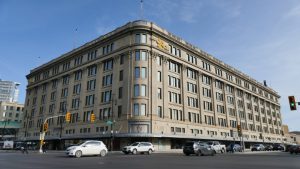On a recent morning, I stood at the southeast corner of the intersection of Portage Avenue and Main Street in downtown Winnipeg, watching cars drive past with the urgency of the daily commute. It was just after 9:00 on a weekday, yet despite the steady flow of traffic, the iconic “crossroads of Canada” felt eerily vacant.
Hockey fans flock here to celebrate playoff victories. Protestors choose to stage rallies here for maximum visibility. On Canada Day 2017, thousands of Winnipeggers clad in red formed the shape of a giant maple leaf in the middle of the street. But on any given day, this historic intersection is mostly devoid of human life because, for 40 years, it’s been closed to pedestrians.
Concrete blockades and signage at each of the four corners make it clear that pedestrians are not to cross above ground. Instead, people are ushered down into the Portage and Main circus, an underground concourse connected to a subterranean mall, the Shops of Winnipeg Square, and several other buildings surrounding the intersection. At best, the layout of the underground complex makes for a disorienting experience, particularly for visitors who anticipate a traditional street crossing; at worst, it’s completely inaccessible.
How did this happen? And why has the question of whether or not to reopen the intersection to foot traffic become one of the city’s most contentious debates in recent memory?
A downtown in decline
Winnipeg was built on the traditional lands of the Anishinaabe, Ininew, Oji-Cree, Dene, and Dakota people, at the confluence of two important rivers. It was a major fur-trading post, the birthplace of the Métis Nation, and the heart of the Métis homeland. With the arrival of the Canadian Pacific Railway in the late 1800s, Winnipeg developed into a hub for international trade. The intersection of Portage Avenue and Main Street became a bustling thoroughfare, connecting both pedestrians and vehicles to the theatres, department stores, and places of commerce in the downtown core.
But the removal of Winnipeg’s streetcars in 1955, together with the rise of the personal automobile, a migration of citizens to city suburbs, and the introduction of shopping malls in suburban areas, ushered in a period of urban decline for Winnipeg’s downtown.
By the 1970s, the city’s core was struggling. “There was really a sense that we needed to do something of a mega project,” Jino Distasio, director of the Institute of Urban Studies at the University of Winnipeg, told the CBC in a recent interview.
In his blog West End Dumplings, Winnipeg historian Christian Cassidy cites Trizec, a Toronto-based development group at the time, as the designers of the office tower at 201 Portage and the underground concourse. In exchange for delivering this beacon of economic hope to Winnipeg’s core area, municipal leaders agreed to a deal that would see Portage and Main closed and pedestrians instead directed through the underground mall for 40 years.
Now, downtown Winnipeg is in the midst of a revival, with a growing population of people choosing to live in the core, and multiple large-scale private investments springing up in the nearby Exchange District, on Main Street, at True North Square and at The Forks. With the 40-year deal due to expire, Winnipeg’s city council must decide whether or not the time is right for pedestrians to be reintroduced to Portage and Main.
For a time, it looked as though the famed intersection would reopen. Mayor Brian Bowman campaigned in 2014 on a promise to make it happen during his term, and even went so far as to allocate budget for the removal of the concrete barriers starting in 2019. But with a plebiscite set to take place during the municipal election in October, the plan is now in jeopardy.
To reopen or not to reopen?
According to the Coalition for Portage and Main (Vote Open), a volunteer committee formed shortly after the announcement of the plebiscite, nearly 20,000 people live and work near Portage and Main. The group hopes reintroducing foot traffic at street level will create incentives to open new storefronts in the area. Business owners from every corner of the intersection have already signed letters in support of reopening Portage and Main because they see an opportunity for economic development.
The committee also believes reopening the intersection would resolve what they see as serious accessibility and safety issues in the heart of the core.
The Portage and Main Transportation Study, released by the city in September 2017, found that it takes wheelchair users up to nine minutes to cross Portage and Main, a time that increases when accessibility aids such as elevators and ramps inside the underground circus require repairs or are closed to the public, the latter of which occurs nightly. According to the study, crossing at street level would cut travel times for pedestrians with mobility challenges by 50 to 60 per cent. It would also mean women are no longer forced to navigate isolated stairwells and underground concourses to cross the street, says Vote Open’s Alyson Shane.
But opponents say the cost and the potential disruption to vehicle traffic make the plan to reopen the intersection to pedestrians impractical. Vocal detractors include mayoral candidate Jenny Motkaluk and North Kildonan councillor Jeff Browaty.
“This is going to be really expensive. It’s going to be a detriment to Winnipeggers on buses,” Browaty told the Winnipeg Sun.
“Portage and Main does have some cachet,” he added. “Unfortunately it’s such a major part of our transportation network that it’s not really practical to impede vehicle movements through it.”
Financially, much of the estimated $11.6 million cost to open the intersection would need to be spent on fixing structural issues in the underground circus, regardless of whether or not pedestrian crossings are reintroduced to the intersection at street level.
Although the transportation study found that there could be slight increases to travel times during peak hours for those choosing to commute by vehicle, the reopening of the intersection to pedestrians would improve travel times for those travelling on foot. In turn, the study suggests that the reopening would encourage people to change how they move around the downtown core, with more people opting to walk instead of drive.
The fate of Portage and Main will now be decided by voting citizens via a “yes or no” question on the election ballot. Although the question is non-binding, Mayor Bowman stated on Twitter that “Winnipeggers will expect the results to be honoured, which I’m committed to do regardless of the outcome.”
Ultimately, the expiry of the 40-year deal presents an opportunity to start reimaging how this connective corridor could be used to foster a sense of community in the heart of Winnipeg, says Vote Open’s Shane.
“This is about more than allowing people to cross the street,” she says. “It’s also about investing in a downtown that is welcoming, safe, and accessible, and which contributes to a vibrant and thriving downtown that future generations of Winnipeggers will benefit from and enjoy.”
Carlene Kurdziel is a writer and editor with an interest in urban planning and community development. She lives in Winnipeg.




